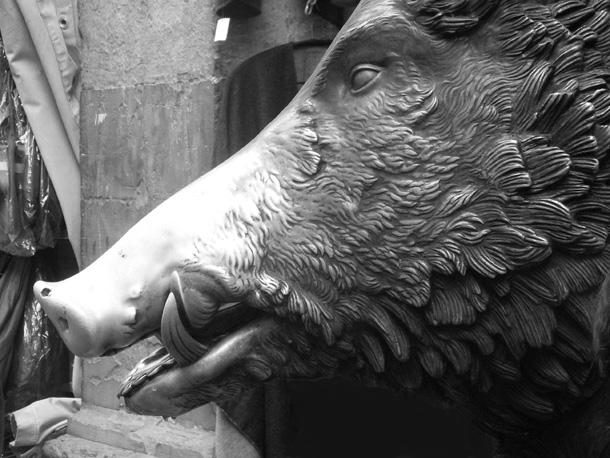Savory Pork: Porchetta and Cinghiale, the Italian Wild Boar
Salami is as Italian as it gets and each type is almost always made with pork. Prosciutto is also a product of pig. At butcher shops in Italy, nearly every part of swine is available for purchase, including whole piglet. It goes without saying that pigs in Italy are a staple food product.
In Rome and its region, Lazio, a roasted adult pig can be found cooked in its entirely to make delicious porchetta. The animal is gutted with the legs and bones – and sometimes head – removed, so what remains is one very large piece of pork with skin. The single, tabletop-sized piece of pork is laid out skin-side down so that the flesh is ready for a heavy dusting of salt, herbs and spices. Then it is rolled or folded tightly shut, wrapped with twine and put in the oven for about eight hours at a low temperature. This causes the succulent meat to retain moisture, while the fat takes on an herby taste from the seasoning, also becoming creamy as butter. The skin becomes crisp and crunchy. Porchetta is a common sight in Rome’s outdoor markets and one that should not be passed up.
Pigs are versatile in use, abundant in number, and easy to feed. However, pigs have cousins called wild boars, which are sometimes more dangerous family members. They originally only roamed free and are commonly found in the regions of Tuscany and Umbria.

Called cinghiale in Italian, wild boars are the wild game of pigs. They have a more intimidating appearance than their pig cousins. Males have large, sharp tusks and when attacking they can use them to pierce anything in the way. Populations of these animals are said to be under-controlled in many continents where mixed breeding has created larger litters.
Whether they are caught in the wild or sometimes now farmed commercially, in Italy and particularly in central Italy, cinghiale is found on menus across the country and for good reason. Their meat is gamier than regular pork, creating an explosion of flavor when marinated or combined with spices. As the animals get older, their meat becomes gamier, though this meat is also tougher and requires moist heat to help break down the muscle’s tight bonds.
More and more butchers are carrying it and more companies are making products with it. Both cinghiale salami and prosciutto di cinghiale are superb. Wild boar ragu mixed with thick, long pasta will put smiles on everyone’s face. A restaurant in Rome, L’Asino d’Oro, even makes a unique savory dish that is easily one of the restaurant’s best: cinghiale in a spicy sauce using chocolate and vinegar.
If cinghiale is on the menu, do not hesitate to sample it, especially in the cooler months of Fall and Winter. Cinghiale is a delicious treat that shouldn’t be missed.
